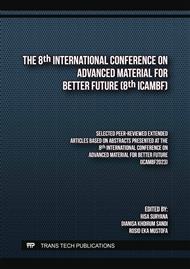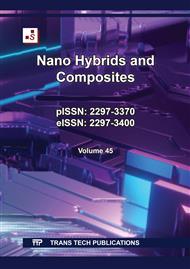[1]
Alzate Acevedo S, Díaz Carrillo ÁJ, Flórez-López E, and Grande-Tovar CD. 2021, Recovery of Banana Waste-Loss from Production and Processing: A Contribution to a Circular Economy. Molecules,26(17), p.5282.
DOI: 10.3390/molecules26175282
Google Scholar
[2]
Zaman, B., Sutrisno, E., Cahyani, F.P. and Raharyani, D.M., 2020, March. Banana tree as natural biofilter for organic contaminant in wastewater treatment. In IOP Conference Series: Earth and Environmental Science, 448(1), p.012031).
DOI: 10.1088/1755-1315/448/1/012031
Google Scholar
[3]
Arafat, K., Nayeem, J., Quadery, A.H., Quaiyyum, M.A. and Jahan, M.S., 2018. Handmade paper from waste banana fibre. Bangladesh Journal of Scientific and Industrial Research, 53(2), pp.83-88.
DOI: 10.3329/bjsir.v53i2.36668
Google Scholar
[4]
Adawiyah, R., Suryanti, V., and Pranoto. 2022. Preparation And Characterization Of Microcrystalline Cellulose From Lembang (Typha angustifolia L). In Journal of Physics, 2190(1), p.012007
DOI: 10.1088/1742-6596/2190/1/012007
Google Scholar
[5]
Pranoto, Suryanti, V., and Adawiyah, R. 2023. Andisol And Microcrystalline Cellulose From Typha Angustifolia For Auramine O Adsorption. Int.J.Adv, 12(1), pp.27-36.
DOI: 10.11591/ijaas.v12.i1.pp27-36
Google Scholar
[6]
Trisnawati, E.W., Cahyani, I.S., Safriyani, D., Pramono, E. and Suryanti, V. 2023. Cellulose, Cellulose Benzoate And Cellulose Citrate From Screw Pine (Pandanus Tectorius) Leaves As PVDF Filler For Improved Permeability And Anti-Fouling Properties. Periodica Polytechnica Chemical Engineering, 67(3), pp.504-515.
DOI: 10.3311/ppch.22043
Google Scholar
[7]
Suryanti, V., Kusumaningsih, T., Safriyani, D. and Cahyani, I.S. 2023. Synthesis and Characterization of Cellulose Ethers from Screw Pine (Pandanus tectorius) Leaves Cellulose as Food Additives. International Journal of Technology, 14(3), 291-319.
DOI: 10.14716/ijtech.v14i3.5288
Google Scholar
[8]
Salama, S. Z., Firdaus, M., & Suryanti, V. 2024. Cellulose Ethers from Banana (Musa balbisiana Colla) Blossom Cellulose: Synthesis and Multivariate Optimization. Indonesian Journal of Chemistry. 24(2024), p.200–212.
DOI: 10.22146/ijc.86769
Google Scholar
[9]
Xie, H., Du, H., Yang, X. and Si, C. 2018. Recent Strategies In Preparation Of Cellulose Nanocrystals And Cellulose Nanofibers Derived From Raw Cellulose Materials. International Journal of Polymer Science,1(25).
DOI: 10.1155/2018/7923068
Google Scholar
[10]
Wang, T. and Zhao, Y., 2021. Optimization Of Bleaching Process For Cellulose Extraction From Apple And Kale Pomace And Evaluation Of Their Potentials As Film Forming Materials. Carbohydrate Polymers, 253, p.117225.
DOI: 10.1016/j.carbpol.2020.117225
Google Scholar
[11]
Tarchoun, A.F., Trache, D., Klapötke, T.M., Derradji, M. and Bessa, W., 2019. Ecofriendly Isolation And Characterization Of Microcrystalline Cellulose From Giant Reed Using Various Acidic Media. Cellulose, 26, pp.7635-7651.
DOI: 10.1007/s10570-019-02672-x
Google Scholar
[12]
Barbosa, R.F.S., Souza, A.G., Ferreira, F.F. and Rosa, D.S., 2019. Isolation And Acetylation Of Cellulose Nanostructures With A Homogeneous System. Carbohydrate polymers, 218, pp.208-217.
DOI: 10.1016/j.carbpol.2019.04.072
Google Scholar
[13]
Phanthong, P., Reubroycharoen, P., Hao, X., Xu, G., Abudula, A. and Guan, G., 2018. Nanocellulose: Extraction and Application. Carbon Resources Conversion, 1(1), pp.32-43.
DOI: 10.1016/j.crcon.2018.05.004
Google Scholar
[14]
Prasanna, N.S. and Mitra, J., 2020. Isolation And Characterization Of Cellulose Nanocrystals From Cucumis Sativus Peels. Carbohydrate polymers, 247, p.116706.
DOI: 10.1016/j.carbpol.2020.116706
Google Scholar
[15]
Rashid, E.S.A., Gul, A., Yehya, W.A.H. and Julkapli, N.M., 2021. Physico-Chemical Characteristics Of Nanocellulose At The Variation Of Catalytic Hydrolysis Process. Heliyon, 7(6).
DOI: 10.1016/j.heliyon.2021.e07267
Google Scholar
[16]
Novo, L.P., Bras, J., García, A., Belgacem, N. and Curvelo, A.A., 2015. Subcritical Water: A Method For Green Production Of Cellulose Nanocrystals. ACS Sustainable Chemistry & Engineering, 3(11), pp.2839-2846.
DOI: 10.1021/acssuschemeng.5b00762
Google Scholar
[17]
Hastati, D.Y., Hambali, E., Syamsu, K. and Warsiki, E., 2021. Enhanced Hydrophobicity Of Nanofibrillated Cellulose Through Surface Modification Using Cetyltrimethylammonium Chloride Derived From Palmityl Alcohol. Waste and Biomass Valorization, 12, pp.5147-5159.
DOI: 10.1007/s12649-021-01366-5
Google Scholar
[18]
do Nascimento, J.H.O., Luz, R.F., Galvão, F.M., Melo, J.D.D., Oliveira, F.R., Ladchumananandasivam, R. And Zille, A., 2015. Extraction And Characterization Of Cellulosic Nanowhisker Obtained From Discarded Cotton Fibers. Materials Today: Proceedings, 2(1), pp.1-7.
DOI: 10.1016/j.matpr.2015.04.001
Google Scholar
[19]
Abitbol, T., Marway, H. and Cranston, E.D., 2014. Surface Modification Of Cellulose Nanocrystals With Cetyltrimethylammonium Bromide. Nordic Pulp & Paper Research Journal, 29(1), pp.46-57.
DOI: 10.3183/npprj-2014-29-01-p046-057
Google Scholar
[20]
Zainuddin, N., Ahmad, I., Kargarzadeh, H. and Ramli, S., 2017. Hydrophobic Kenaf Nanocrystalline Cellulose For The Binding Of Curcumin. Carbohydrate polymers, 163, pp.261-269.
DOI: 10.1016/j.carbpol.2017.01.036
Google Scholar
[21]
Poaty, B., Vardanyan, V., Wilczak, L., Chauve, G. and Riedl, B., 2014. Modification Of Cellulose Nanocrystals As Reinforcement Derivatives For Wood Coatings. Progress in Organic Coatings, 77(4), pp.813-820.
DOI: 10.1016/j.porgcoat.2014.01.009
Google Scholar
[22]
Xiang, S., Ma, X., Liao, S., Shi, H., Liu, C., Shen, Y., Lv, X., Yuan, M., Fan, G., Huang, J. and Sun, X., 2019. Cellulose Nanocrystal Surface Cationization: A New Fungicide With High Activity Against Phycomycetes Capsici. Molecules, 24(13), p.2467.
DOI: 10.3390/molecules24132467
Google Scholar
[23]
Lu, J., Askeland, P. and Drzal, L.T., 2008. Surface Modification Of Microfibrillated Cellulose For Epoxy Composite Applications. Polymer, 49(5), pp.1285-1296.
DOI: 10.1016/j.polymer.2008.01.028
Google Scholar
[24]
Nasution, H. and Wijaya, F., 2020. Optimization of Hydrolysis Temperature and Sulfuric Acid Concentration in Making Nanocellulose Based on Kepok Banana Stem Fiber (Musa acuminata x balbisiana). Jurnal Teknik Kimia USU, 9(1), pp.1-6.
DOI: 10.32734/jtk.v9i1.3532
Google Scholar



